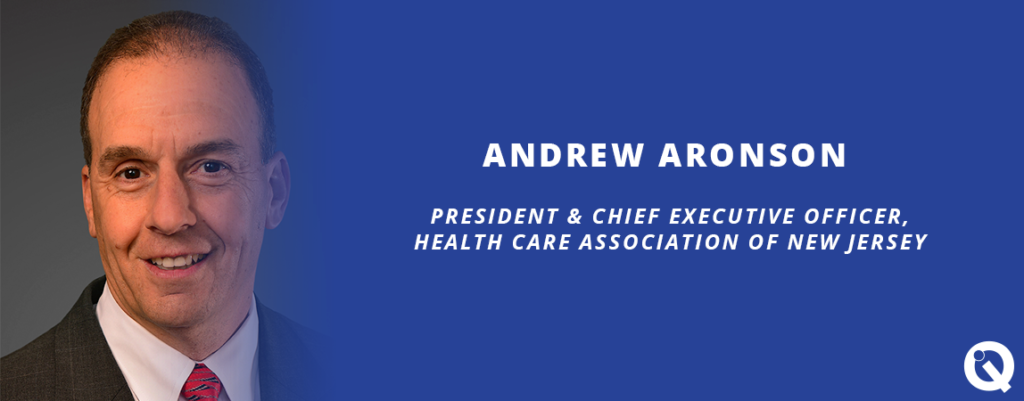Andrew P. Aronson is President and CEO of the Health Care Association of New Jersey (HCANJ), which promotes quality care for residents in New Jersey’s long term care facilities. HCANJ is a member of the Quality Institute’s Association Council.
The federal government is keenly focused on defining minimum staffing requirements that nursing homes will need to meet to ensure all residents are provided safe, high-quality care, and nursing home workers have the support they need. What role will HCANJ play in this process?
We’re involved with the federal discussions as part of our national organization, the American Healthcare Association. To promote quality care, federal standards would have to be flexible enough to allow providers to tailor their staff to meet the specific needs of their residents. For example, the direct care staff of a nursing home with a specialized vent or pulmonary unit might look very different from the staff of a building with a specialty such as memory care or behavioral management.
Also, standards would have to include all direct care staff. More nursing homes are using nurse practitioners or advanced practice nurses. In New Jersey, we have specialized infection preventionists. Many states have other categories, such as feeding aids or medical technicians. These are examples of workers that would need to be considered.
Staffing standards also need to consider that staffing shortages currently exist. In the current environment, the standards need to be both attainable and affordable. Creating standards that can’t be met by nursing homes because the staff doesn’t exist or because the required level of staffing is beyond the financial capability of many facilities would drive down quality of care and end up harming nursing home residents.
The pandemic has made the job of working in a nursing home even more challenging. How are your members recruiting and retaining employees?
Our members have increased wages dramatically. Benefits have increased, schedule flexibility has increased. Financially, providers are doing all that they can to attract and retain employees, yet there continues to be an unprecedented crisis with the workforce. A shortage existed pre-pandemic. Since the beginning of the pandemic, the long-term care sector is down about 300,000 employees nationally from before the pandemic. The pandemic has clearly further exacerbated the existing shortage.
Although there’s no quick fix, I’ve been encouraged by the efforts that are going on to try to incorporate things like gerontology and long-term care into the curriculum of people who are being trained for careers in health care. By incorporating long-term care into the curricula, we can get people thinking about long term care early in their education. And there’s a great career ladder in long-term care where people can start off as CNAs and develop into RNs and become nurse managers and become directors of nursing. And that relatively quick career path is unique to long-term care. I think in the long run, we’ll be able to attract more people into the industry, but in the short term, it’s a problem that doesn’t have an easy solution.
What data and steps need to happen to advance health equity?
In nursing homes, we have data that clearly shows the disparities that exist. Generally, nursing homes that rely most heavily on Medicaid payment rates — which are lower than Medicare or private pay rates — are the facilities that treat those who traditionally are underserved in our health care system. New Jersey’s Medicaid payment system virtually assures that the facilities that treat a high population of Medicaid residents struggle financially; they struggle to recruit and retain staff; they struggle to maintain their buildings; they struggle to provide the complex care that current nursing home residents need.
Those situations result in lower star ratings and more deficiencies. The data is clear in that regard. Unfortunately, policymakers have typically reacted to things like deficiencies and lower star ratings with punitive actions. These punitive actions create a cycle where underfunded nursing homes become even more underfunded, and the quality of care that gets provided to those residents gets driven down.
We need a more data-driven system instead of relying upon flawed measures like surveys or five-star ratings. We could collect both cost data from facilities to figure out their payment rate and real-time clinical data so we can see what’s going on clinically with the residents of these buildings and use that data to drive quality.
What do you want the Quality Institute’s members and partners to know about HCANJ’s priorities for the balance of this year and next?
I came to HCANJ in February of 2021, and my goal has been to work with all the stakeholders in long-term care and talk to them about better aligning our system to drive quality in long-term care. We have a disjointed regulatory system as it relates to long-term care. We have a Medicaid payment system that creates one set of incentives; we have statutory and regulatory mandates that pull in a completely different direction. My simple message to people is we can achieve whatever goals we set if we align everything so that it all falls together.
New Jersey took a significant step in that direction in June of 2022 with the release of The Long-term Care Study that was prepared for the Department of Human Services. It recommended a new Medicaid payment system in New Jersey for state fiscal year of 2025. And we look forward to working with all the stakeholders, the Quality Institute, the State, the Department of Human Services, to implement that system, because that’s a huge step in the right direction.
We like to ask a personal question so our readers can learn more about you. Where would we find you on a day off from work?
For many years, my wife and I would have been found at one of our kids’ sporting events. But now that they’re grown, you’re more likely to find me on a golf course or just relaxing with family and friends.

